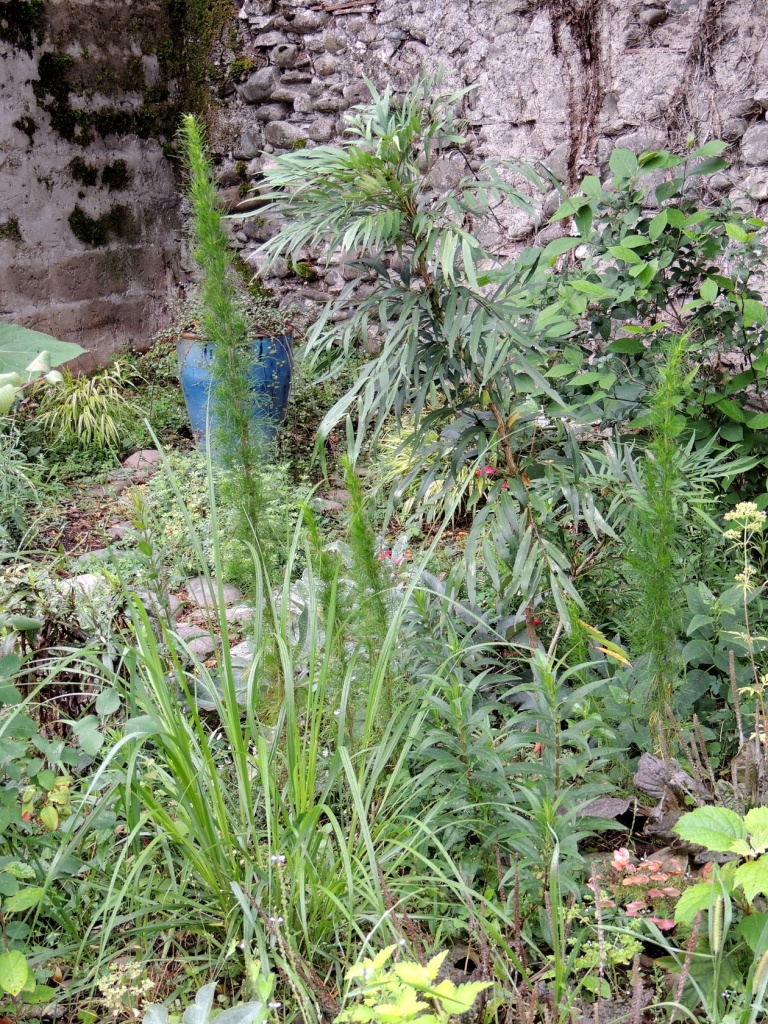
I don’t remember when I first fell for abutilons big time. It’s the bell shape, the colours, the pretty, lax foliage in a maple shape- the colours maybe most of all, I am still lusting after a plant of Abutilon ‘Orange Hot Lava’ an American introduction which is taking its time to infiltrate France. Some UK nurseries have started to stock it. The abutilon is generally tougher than the Victorians thought. It’s largely South American lineage would seem to indicate a delicacy that it doesn’t usually need. If you think of it like a large dahlia, that would probably be enough to keep it going. Though if you regularly have winter night-time temperatures below -4C, the plant would be happier and safer in an open, roofed space with some wall protection.
I started out with an unknown orange one, see below. It was just a cutting and I planted it near the house, in one of our stony soil rectangles, and pretty much left it. It coped with annual fortnights of cold down to -10C, and always bounced back. The free draining conditions probably helped, so I’m not proposing those temperatures as a recipe for success anywhere! It became a rangy shrub just under 2m tall, about 1.5m wide, and it often flowered for almost 10 months of the year, with an endless supply of these soft orange flowers. It was such a staple that when we left Tostat, I forgot to take cuttings. I regret that!

I had no luck with the red ones, an unknown cutting failed, and ‘Red Trumpet’ passed away here in Oloron in the Barn Garden after limping along for a year when we moved. Another opportunity beckons when I next bump into one…
Meantime, a beautiful Abutilon, see the top photograph, Abutilon pictum has gone from strength to strength here in Oloron, and is in its pot, underneath the collapsing banana tree, outside, but with the substantial protection of the big banana leaves giving it a bit of a duvet. I bought this as a well rooted cutting from the legendary Gill Pound in Caunes Minervois, when she did a final sale before retiring from her nursery business. It is such a good colour, deep marmelade with prominent red veining, and is still flowering now in the winter, although the cold does dim down the colour a lot. Each spring, I just prune it a fair bit, as it is leggy, and use a seaweed fertiliser diluted with water. This year I will repot it, just to give it a freshen-up. Full sun is a bit much for it here, assuming we continue in the same vein as last year, so I just bring it out a bit more from under the banana, so that it gets some but not all of the sun.
Be careful though, many nurseries offer Abutilon pictum Thompsonii, which has variegated leaves. I find them a bit sickly in colour myself, so if you like the plain green leaves, you need to find Abutilon pictum without the Thompson tag, they are a bit harder to find.

Making a lightening dash to Leeds last weekend, we walked around Temple Newsam House and park. Inside the old glasshouses inside the walled garden, there were a number of good abutilons under glass, including this red one below, with a very old label just describing it, in fairly general terms, as Abutilon x hybridum ‘Light Red’. Red is such a hard colour to photograph and you have to imagine the colour as a really vibrant scarlet. Growing against wires on a wall, it was easily 3-4m high and wide, and very floriferous.


It reminded me of why I love them, though I prefer it as a shrub shape. But, below, is a great way to grow Abutilon megapotamicum. It loves a wall, or a structure to flop over, and has these bi-coloured ‘chinese lantern’ style flowers. It is really pretty tough, any space, any situation, barring total dry and hot sun. I have one in the Barn Garden, romping away, and a tad too enthusiastic for the wires I put up, so I am thinking of collecting it all up and draping it over a bamboo triangle or some such this Spring. And on an old photograph on my old camera from the early days of blogging, I found this photo taken in Gill Pound’s garden. It’s a full circle back to almost where I started!
Paddock Plants have a great selection in the UK. Mouthwatering. More about Gill Pound and her legacy here.























































